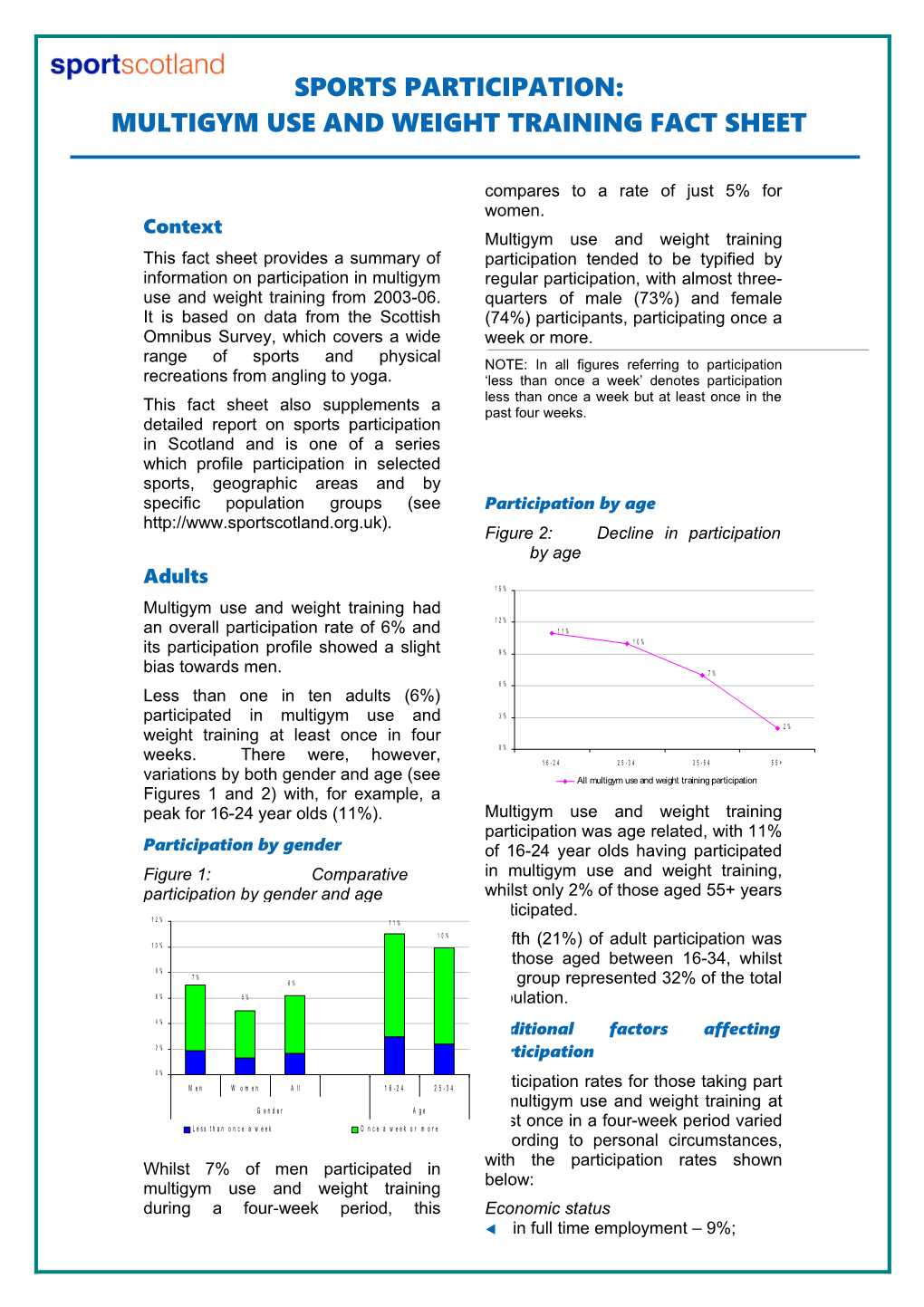SPORTS PARTICIPATION:
Multigym USE AND Weight training FACT SHEET
Context
This fact sheet provides a summary of information on participation in multigym use and weight training from 2003-06. It is based on data from the Scottish Omnibus Survey, which covers a wide range of sports and physical recreations from angling to yoga.
This fact sheet also supplements a detailed report on sports participation in Scotland and is one of a series which profile participation in selected sports, geographic areas and by specific population groups (see
Adults
Multigym use and weight training had an overall participation rate of 6% and its participation profile showed a slight bias towards men.
Less than one in ten adults (6%) participated in multigym use and weight training at least once in four weeks. There were, however, variations by both gender and age (see Figures 1 and 2) with, for example, a peak for 16-24 year olds (11%).
Participation by gender
Figure 1:Comparative participation by gender and age
Whilst 7% of men participated in multigym use and weight training during a four-week period, this compares to a rate of just 5% for women.
Multigym use and weight training participation tended to be typified by regular participation, with almost three-quarters of male (73%) and female (74%) participants, participating once a week or more.
NOTE: In all figures referring to participation ‘less than once a week’ denotes participation less than once a week but at least once in the past four weeks.
Participation by age
Figure 2: Decline in participation by age
Multigym use and weight training participation was age related, with 11% of 16-24 year olds having participated in multigym use and weight training, whilst only 2% of those aged 55+ years participated.
A fifth (21%) of adult participation was by those aged between 16-34, whilst this group represented 32% of the total population.
Additional factors affecting participation
Participation rates for those taking part in multigym use and weight training at least once in a four-week period varied according to personal circumstances, with the participation rates shown below:
Economic status
in full time employment – 9%;
in part time employment – 6%;
not in employment – 3%; and
students – 13%.
Social class
upper/middle class (AB) – 9%;
lower middle class (C1) – 7%;
skilled manual workers (C2) – 6%; and
semi/unskilled workers and those not in employment (DE) – 3%.
Deprivation – participation rates for those living in the country’s more deprived areas were 3% whilst rates for those living outside deprived areas were 7%.
Limiting long-term illness or disability (LLTI)
with an LLTI – 2%; and
without an LLTI – 7%.
Car ownership/access to a car
no car – 3%;
one car – 6%; and
two or more cars – 10%.
Local authority grouping
East – 8%;
Glasgow – 5%;
Midland – 6%;
North – 8%;
South – 5%; and
West – 6%.
Club membership (participants only)
Half (50%) of male participants(those who participated in multigym use and weight training at least once every four weeks) were club members, compared to 64% of women.
Four-fifths (78%) of club members participated in multigym use and weight training once a week or more, compared to two-thirds (66%) of non-club members.
Frequency, duration and nature of participation (participants only)
Figure 3: Frequency of participation
Frequency of participation – over a quarter (27%) of participants took part in multigym use and weight training less than once a week; whilst almost six in ten (59%) did so twice a week or more.
Figure 4: Duration of participation
Duration of participation – 59% of participation in multigym and weights activities, over the four weeks prior to the survey, was for between three-quarters of an hour and an hour and a half.
Figure 5: Nature of participation
Nature of participation – over the four weeks prior to the survey, more than eight tenths (81%) of participation in multigym use and weight training was on a casual basis while 17% involved organised training, coaching or lessons.
NOTE: Figures for the nature of participation are based on a count of casual, training and competitive sessions for each participant during a four weeks period.
See next page for advisory notes
